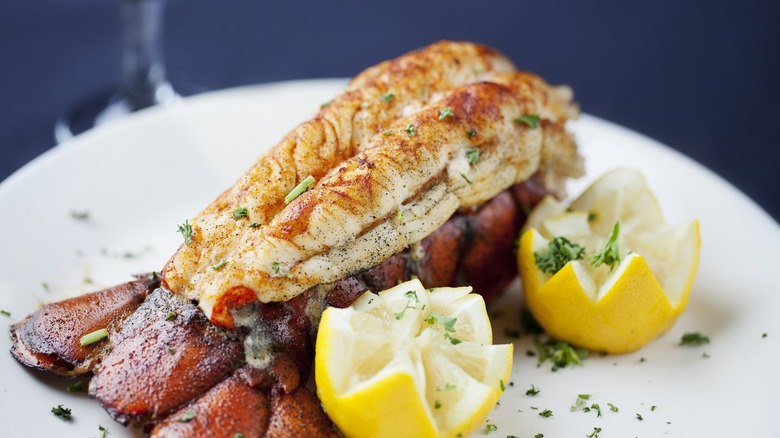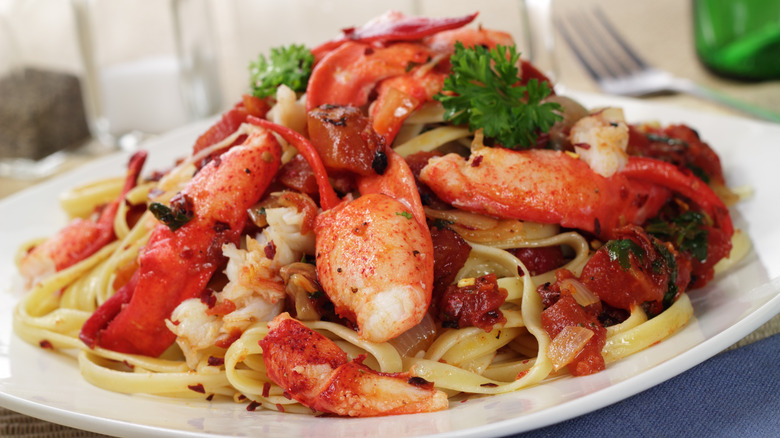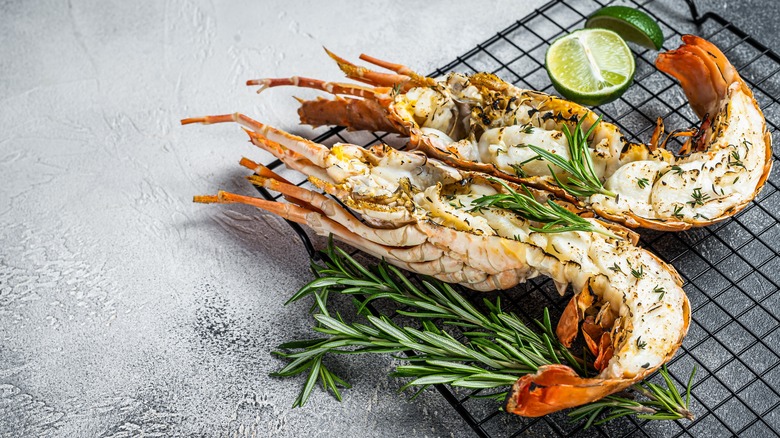The Best Way To Cook Cold Vs Warm Water Lobster
Lobster is incredibly versatile. The once-slandered crustacean — it was seen as cheap and even compared to insects – is enjoyed the world over on home dinner tables and in Michelin-starred restaurant kitchens. While there are more than 70 subspecies (via the Marine Education Society of Australasia), they generally fall into two categories: cold-water and warm-water lobster.
Cold-water lobsters like Homarus americanus are the classic lobster poster boys thanks to the vibrant red color they turn after cooking. These are what people are referring to when they say Maine or Atlantic lobster. Their habitats are the rocky shores of the North Atlantic Ocean from North Carolina to Canada. When it comes time to cook them, cold-water lobsters are best cooked simply using methods like boiling, steaming, and pan-searing.
Warm-water lobsters, or spiny lobsters (also known as rock lobsters) can be found in many different areas, from the coasts of California and Florida to the waters surrounding Australia. They are part of the Palinuridae family, meaning they're a different kind of arthropod. Instead of claws on their front legs, they're characterized by long, spiky antennae. When you're ready to butterfly and cook your own lobster, consider grilling or broiling them. Their tails are firmer and often more filling since they contain more meat in their abdomens than their Maine counterparts. But be warned: These differences will impact the flavor, texture, and preparation of your dish. Understanding when to use each type will not only expand your culinary knowledge but also help you prepare and grill lobster like a pro and determine what you should serve as a side.
Boil, steam, and poach cold water lobsters
Make sure you've got enough kitchen space to work with Maine lobsters from scratch because they can get quite large, averaging 1 to 4 pounds. These crustaceans are sweet and tender and have several parts to cook with, such as the claws, tail, head, legs, and body.
Boiling is one of the most traditional and popular ways to cook whole lobster. Figure around eight minutes for every pound of lobster, adding five minutes per extra pound. Some chefs boil with filtered seawater because of its natural saltiness, but you can also generously salt tap water. Salt water also works for steaming, where you're using only a couple of inches of water to lock in its natural flavors. Expect it to take around 10 minutes for a 1-pound lobster (adding roughly 8 additional minutes per pound).
Lobster is finished cooking when its meat has gone from clear to white and it has an internal temperature of 140 degrees Fahrenheit. If you're looking to amp up the flavor, try poaching your lobster in a combination of white wine, lemon juice, and butter. You can also make a sauce from the poaching liquid.
Maine lobsters are of course perfect for that New England classic, the lobster roll. Salad, roasted corn, and boiled or baked potatoes all make great sides. Maine lobsters also work well with Italian-American dishes where you can serve them as the entree or cook them into a creamy risotto. You'll love the way dishes like lobster fra diavolo and linguine all'astice incorporate cold-water lobster with tomato and garlic.
Grill, broil, and spice up warm water lobsters
Warm-water lobsters are perfect for high-heat cooking. Butterfly the tails, brush them with olive oil and melted butter, and skewer the tails on the grill. You can keep the grill going by roasting some tomatoes, bell peppers, onion, and corn for a side of vegetables. But before you light any fires, make sure the grill is clean and that you coat the rack in cooking oil to achieve the best taste from your ingredients. You can repeat these steps for broiling spiny lobster tails, but make sure to place your tails in a broiler pan on the top rack of your oven. Season them with salt and pepper and garnish with parsley and chives, brush them with compound butter made from herbs and citrus, or dust them in Old Bay for a spicy kick.
Spiny lobsters have a hardier texture and sweet marine quality ideal for cutting up and cooking into dishes where you can temper their delicately briny taste with spices and sauces. They have a place in Caribbean and Indian cuisine where there's an emphasis on seasonings like chadon beni, turmeric, cumin, and coriander. For instance, you can cook them in a rum-jerk sauce and serve them with coconut rice or mango-jalapeño salsa. Think of using spiny lobsters the next time you whip up a ceviche, seafood boil, stew, or jerk dish.


